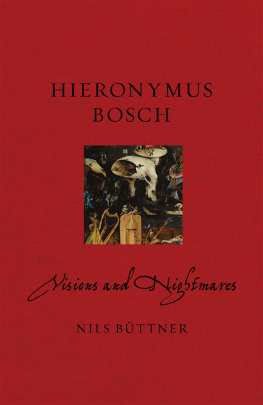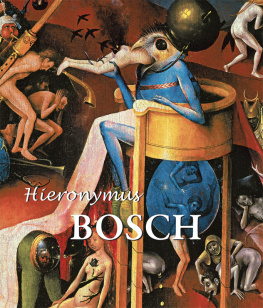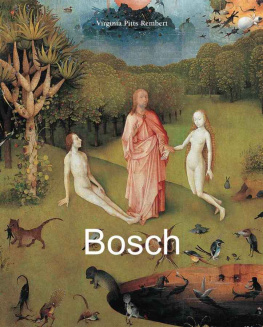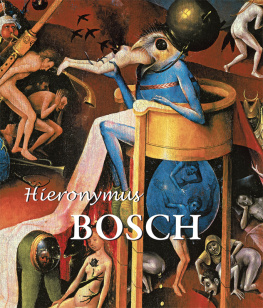HIERONYMUS BOSCH

 Books in the RENAISSANCE LIVES series explore and illustrate the life histories and achievements of significant artists, intellectuals and scientists in the early modern world. They delve into literature, philosophy, the history of art, science and natural history and cover narratives of exploration, statecraft and technology.
Books in the RENAISSANCE LIVES series explore and illustrate the life histories and achievements of significant artists, intellectuals and scientists in the early modern world. They delve into literature, philosophy, the history of art, science and natural history and cover narratives of exploration, statecraft and technology.
Series Editor: Franois Quiviger
HIERONYMUS
BOSCH
Visions and Nightmares
NILS BTTNER
REAKTION BOOKS
Published by Reaktion Books Ltd
Unit 32, Waterside
4448, Wharf Road
London N1 7UX, UK
www.reaktionbooks.co.uk
First published in English 2016
Copyright Nils Bttner 2016
Translated by Anthony Mathews
All rights reserved
No part of this publication may be reproduced, stored in a retrieval system, or transmitted, in any form or by any means, electronic, mechanical, photocopying, recording or otherwise, without the prior permission of the publishers
Page references in the Photo Acknowledgments and
Index match the printed edition of this book.
Printed and bound in China by C&C Offset Printing Co., Ltd
A catalogue record for this book is available from the British Library
eISBN: 9781780236148
CONTENTS

1 Johannes Wierix (?), Hieronymus Bosch, 1572, engraving.
ONE
Visions and Nightmares
 IERONYMUS BOSCH was famous throughout the world even in his own lifetime, and his works remained sought-after collectors items long after his death. His pictures were appreciated not just in the Netherlands and Spain but also beyond the Alps, in Italy. He was one of the few northern European painters whom Giorgio Vasari thought worthy of mention in his widely read collection of artists biographies. Vasari praised the originality of the painter from s-Hertogenbosch, citing some of the works known to him from engravings, and so many other fantastic and wanton inventions that it would be tiresome to recount them all. An early example of this can be seen in a poem by the painter and writer Dominicus Lampsonius, which gained wide circulation:
IERONYMUS BOSCH was famous throughout the world even in his own lifetime, and his works remained sought-after collectors items long after his death. His pictures were appreciated not just in the Netherlands and Spain but also beyond the Alps, in Italy. He was one of the few northern European painters whom Giorgio Vasari thought worthy of mention in his widely read collection of artists biographies. Vasari praised the originality of the painter from s-Hertogenbosch, citing some of the works known to him from engravings, and so many other fantastic and wanton inventions that it would be tiresome to recount them all. An early example of this can be seen in a poem by the painter and writer Dominicus Lampsonius, which gained wide circulation:
Jeroon Bos, what means your frightened face
And pale appearance? It seems as though you just
Saw all infernal spectres fly close around your ears.
I think that all the deepest rings of miserly Pluto
Were revealed, and the wide habitations of Hell
Opened to you because you are so art-full
In painting with your right hand depictions
Of all that the deepest bowels of Hell contain.
These lines were used as the caption to an image first published in 1572 in a series of engravings edited by Hieronymus Cock, which were frequently reprinted elsewhere ( A good number of the works by his imitators and admirers were inscribed with his name, which became synonymous with the depiction of visual nightmares.
In the literary sphere, this is seen above all in the writing of Francisco Gmez de Quevedo y Villegas, in whose Sueos y discursos Bosch was closely identified with visions and nightmares. We know considerably more about Bosch now. Today, his biography is better documented than most Dutch painters of the period, allowing us to gain an extremely detailed picture of his life.

).
Since then well over a thousand publications on Hieronymus Bosch have appeared. They mainly attempt to account for his seemingly mysterious world of imagery and only rarely focus on his style; it is very rare indeed to find both things being taken into account.
The painters home town, s-Hertogenbosch, from which he took his name and which is mostly referred to by its inhabitants as Den Bosch, is situated in the Netherlands. It is as remote from Haarlem in Holland proper as it is from Antwerp in what is now Belgium. This fact is significant for the interpretation of Boschs work; his alleged distinctiveness in the field of what is often called the art of the Early Netherlandish masters has been interpreted as a first indication of a specific northern Dutch characteristic by an art-historical approach based on national schools. It is the northern Netherlands that is also usually identified with the paintings of the so-called Dutch Golden Age. But Belgium did not yet exist in Boschs day and the Netherlands was not to become a unified cultural area for some time. Bosch was strongly influenced by painters from the southern Netherlands, and he had a considerable following there; the exceptionally large number of copies and imitations that were produced in his lifetime are clear proof of this.
Apart from his pictures, Bosch did not leave anything of great interest to future interpreters. There are no diaries, He has been seen as an Adamite, a Cathar, an astrologer, an alchemist or a psychopath and was said to have used magic potions or psychedelic drugs. People have also looked for explanations behind his paintings based on the interpretation of dreams, psychoanalysis and the collective unconscious.
Detailed art-historical analysis of Boschs style has resulted in a considerable reduction in the number of his works that can be authenticated. In 1937, Charles de Tolnay could put a figure of 41 on the number of pictures by Boschs own hand, but by 1965 he had dropped the number to 36.The frequent reduction of the size of the oeuvre has had the effect of shifting the focus when it comes to subject-matter. In place of the darkly fantastical scenes of Hell populated by odd hybrid creatures, we now find an emphasis on the more traditional motifs of Christian iconography. A lot of works that were once seen as crucial are now attributed to imitators or admirers. As a result, the many interpretations based on the artists biography and psychopathology have become increasingly suspect; they run counter to the wealth of documentary evidence providing clues to the everyday life of the painter. This book is based on these sources and on the paintings that have been established as the work of Boschs own hand.
The following history is rooted in the practice of historical writing and is based first and foremost on extant material sources. This practice guarantees what the historian Reinhart Koselleck calls the right of veto on the part of the sources. Although the large body of surviving material evidence, the pictures, records and documents, do not determine what can or should be said about the historical context, they do determine what cannot be said. What follows can be said.
TWO
A Painter in Den Bosch
 T WAS NOT THE FIRST TIME the painter Anthonius van Aken had gone to the town hall of Den Bosch (s-Hertogenbosch) when, on 5 April 1474, he accompanied his daughter Katharina, at that time still a minor, to arrange the payment of a lease. Today the Latinized form of the name Hieronymus Bosch has become standard, and that is what will be used here.
T WAS NOT THE FIRST TIME the painter Anthonius van Aken had gone to the town hall of Den Bosch (s-Hertogenbosch) when, on 5 April 1474, he accompanied his daughter Katharina, at that time still a minor, to arrange the payment of a lease. Today the Latinized form of the name Hieronymus Bosch has become standard, and that is what will be used here.
Altogether, more than fifty official records providing information about Boschs life have survived from a period of 42 years. There is no evidence relating to his education but he must have attended the (Latin) grammar school. This is not only reflected in his subsequent career, but can be assumed from his background. According to the town chronicle written by Albertus Cuperinus around the middle of the sixteenth century, it was customary in s-Hertogenbosch for children either to be sent to school from an early age or taught a trade.



![Majkl Konnelli - The Night Fire [Harry Bosch - 22]](/uploads/posts/book/873181/thumbs/majkl-konnelli-the-night-fire-harry-bosch-22.jpg)












 Books in the RENAISSANCE LIVES series explore and illustrate the life histories and achievements of significant artists, intellectuals and scientists in the early modern world. They delve into literature, philosophy, the history of art, science and natural history and cover narratives of exploration, statecraft and technology.
Books in the RENAISSANCE LIVES series explore and illustrate the life histories and achievements of significant artists, intellectuals and scientists in the early modern world. They delve into literature, philosophy, the history of art, science and natural history and cover narratives of exploration, statecraft and technology.
 IERONYMUS BOSCH was famous throughout the world even in his own lifetime, and his works remained sought-after collectors items long after his death. His pictures were appreciated not just in the Netherlands and Spain but also beyond the Alps, in Italy. He was one of the few northern European painters whom Giorgio Vasari thought worthy of mention in his widely read collection of artists biographies. Vasari praised the originality of the painter from s-Hertogenbosch, citing some of the works known to him from engravings, and so many other fantastic and wanton inventions that it would be tiresome to recount them all. An early example of this can be seen in a poem by the painter and writer Dominicus Lampsonius, which gained wide circulation:
IERONYMUS BOSCH was famous throughout the world even in his own lifetime, and his works remained sought-after collectors items long after his death. His pictures were appreciated not just in the Netherlands and Spain but also beyond the Alps, in Italy. He was one of the few northern European painters whom Giorgio Vasari thought worthy of mention in his widely read collection of artists biographies. Vasari praised the originality of the painter from s-Hertogenbosch, citing some of the works known to him from engravings, and so many other fantastic and wanton inventions that it would be tiresome to recount them all. An early example of this can be seen in a poem by the painter and writer Dominicus Lampsonius, which gained wide circulation:
 T WAS NOT THE FIRST TIME the painter Anthonius van Aken had gone to the town hall of Den Bosch (s-Hertogenbosch) when, on 5 April 1474, he accompanied his daughter Katharina, at that time still a minor, to arrange the payment of a lease. Today the Latinized form of the name Hieronymus Bosch has become standard, and that is what will be used here.
T WAS NOT THE FIRST TIME the painter Anthonius van Aken had gone to the town hall of Den Bosch (s-Hertogenbosch) when, on 5 April 1474, he accompanied his daughter Katharina, at that time still a minor, to arrange the payment of a lease. Today the Latinized form of the name Hieronymus Bosch has become standard, and that is what will be used here.